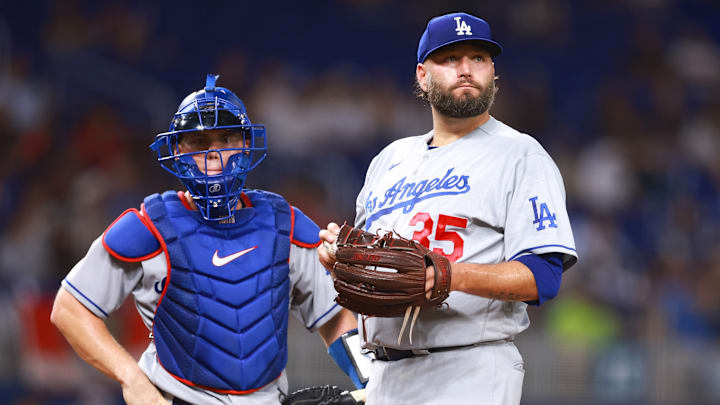The Dodgers have had well-documented struggles with their pitching rotation all year long. Add in the recent (inside and outside-the-box) issues like Julio Urías' arrest, Clayton Kershaw's lingering injury, Lance Lynn looking more like 2023 White Sox Lance Lynn and the news that Walker Buehler will not return this season at all and, all of a sudden, a team that usually prides itself on pitching has a rotation with major pitfalls heading into the postseason. Since the trade deadline has already passed, how can the Dodgers fix that problem?
The answer to the problems of the present might actually be to copy a Dodgers team from the past. That is because in the Dodgers' 2020 postseason, where Los Angeles ended their franchise's 32-year World Series drought, the Dodgers turned to an unorthodox rotation setup. LA arranged an opener (and subsequent bullpen game) in Games 2 and 6 of the World Series, sandwiched in the rotation between Kershaw and Buehler.
In 2020, the Dodgers utilized six starters in their rotation during most of the regular season. Ross Stripling was eventually traded to the Blue Jays to decrease that number to five, and since both Tony Gonsolin and Dustin May were in their rookie seasons, the Dodgers did not want to rely on either to be true starters for postseason games. As a result, the three starters with playoff experience (Kershaw, Buehler and Urías) were used in their regular roles (of course, until the end of Game 6), but May and Gonsolin were used in various roles.
The Dodgers smartly placed the pseudo-bullpen game in the rotation between the two most trustworthy starters, Kershaw and Buehler, hoping that those two would eat enough innings to allow the bullpen to stay fresh, while they played a major role in the games in between. Although the Dodgers lost Game 2 of the 2020 World Series, where Gonsolin served as the opener, May pitched 1.1 innings, and veteran starter Alex Wood pitched two innings, the gamble paid off in Game 6. That game, of course, is when the Dodgers clinched the 2020 World Series. Gonsolin was the opener, Wood pitched out of the bullpen, and with Buehler projected to start Game 7, Urías, who started Game 4, was available out of the bullpen. He had the 2.1-inning save to close out the World Series.
How can Dodgers copy 2020 blueprint to 2023 World Series run?
So why am I going back in history and describing the 2020 World Series pitching rotation in vivid detail? Well, this season has a similar potential situation developing. The Dodgers have Kershaw, Lynn and Ryan Yarbrough (who pitched for the Rays in the 2020 World Series) as starters on the active roster with playoff experience. Then there are three rookies: Bobby Miller, Ryan Pepiot and Emmet Sheehan, who have pitched throughout the 2023 season, but have no playoff experience. The Dodgers should go the 2020 route in this year's postseason to maximize the potential of the rotation while also valuing playoff experience.
If he is fully healthy, it can be safely assumed that Kershaw will start the Dodgers' first game of the postseason. Frankly, even if Kershaw is not his normal self, he still might begin the postseason as the No. 1 starter. But after Kershaw, where do the Dodgers go? Does Lynn get his start because of experience, or do Pepiot and/or Miller deserve it because of their strong rookie seasons? Regardless of what the Dodgers decide to do, the 2020 blueprint makes perfect sense for this team. Using the 2020 plan, the second game would be a bullpen game, with Pepiot as the opener and Sheehan serving as a multi-inning reliever out of the bullpen.
If the Dodgers go the bullpen game route, with Pepiot and Sheehan both playing a role in that game, that still leaves Miller, Lynn and Yarbrough as available options who are stretched out to pitch at least multiple innings. There are clear downsides to starting Lynn, but he might end up as the Game 3 starter because of his ability to eat innings, which would pair well with the Game 2 bullpen game described in this scenario. Then, a Miller and Yarbrough piggyback game would fill out Game 4, and voila! The Dodgers can solve their impending postseason dilemma easily.
Okay, we can all agree on the fact that relying on Pepiot and Sheehan, as well as Lynn, for Games 2 and 3, can go poorly for various reasons, but the Dodgers are going to have to take some risks. The rotation at the beginning of the year was supposed to have Gonsolin and Urías playing significant roles. Paired with Kershaw's injury struggles and May's disappearance, the Dodgers have not been given many options other than getting creative, relying on some rookies and struggling veterans, and just hoping that the offense can support a flawed staff enough to propel this team to a World Series. Potent lineups like the Braves and Phillies are waiting to feast on any opposing pitchers, and the Dodgers will have a tough road regardless of how they choose to manage the staff.
